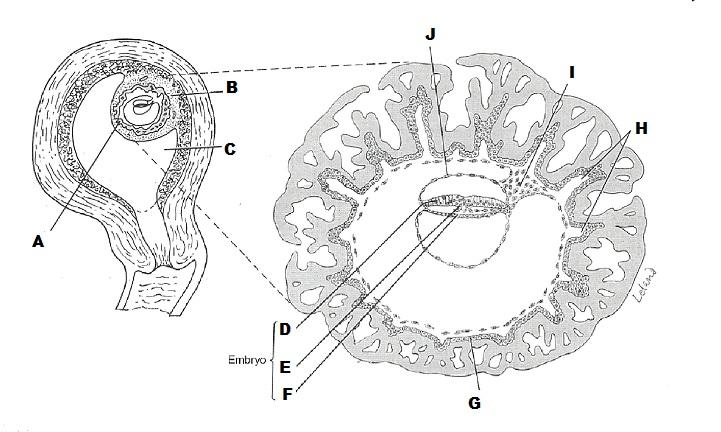Define Zygote
Fertilized egg
Describe how you were able to tell by observation when a sea urchin egg was fertilized
A fertilized membrane is present beneath the outer jelly coat.
fusion of male and female pronuclei
fertilization
a solid ball of embryonic cells
morula
process of rapid mitotic cell division w/o intervening growth periods
cleavage
Combination of egg and sperm
zygote
Process involving cell rearrangements to form the three primary germ layers
gastrulation
Embryonic stage in which the embryo consists of a hollow ball of cells
blastula
What is the importance of cleavage in embryonic development?
It provides a large number of smaller cells for morphogenesis
How is cleavage different from mitotic cell division, which occurs later in life?
During cleavage there are no intervening growth periods between the successive divisions. Therefore the cells get smaller & smaller, bu the embryonic mass remains essentially the same size.
Produces the embryonic body
inner cell mass
becomes the chorion and cooperates with uterine tissues to form the placenta
trophoblast
produces the amnion, yolk sac and allantois
inner cell mast
produces the primordial germ cells (an embryonic membrane)
yolk sac
An embryonic membrane that provides the structural basis for the body stalk or umbilical cord
allantois

A. Decidua basalis
B. Decidua capsularis
C. Uterine Cavity
D. Ectoderm
E. Mesoderm
F. Endoderm
G. Chorion
H. Chorionic villi
I. Body Stalk
J. Amnion
Explain the process and importance of gastrulation
It involves the migration, movement & rearrangement of embryonic cells, so that a 3-layer embryo is formed (3 primary germ layers)
What is the functionof the amnionand the amniotic fluid?
The amnion is a protective, fluid filled sac that surrounds the embryo. The fluid buffer protects theembryo from phsical trauma & prevents adhesion formation during rapid growth.
Describe the process of implantation, noting the role of the tropoblast cells
The tropoblast cells overlying the inner cell mass adhere to the endometrium. The trophoblast cells then secrete enzymes that erode the endometrial lining to reach the vascular supply beneath.
How many days after fertilization is implatation generally completed?
12-14
What event in the female menstrual cycle ordinarily occurs around mid cycle if implantation does not occur
Menses, because this is usually the 14th day after ovulation.
What name is given to the part of the uterine wall directly under the implanting embryo? What is surrounding the rest of the embryonic structure?
Decidua basalis; decidua capsularis
What does decidua mean?
"falls off" or is subject to periodic shedding
How is the term "deciduas" applied to pregnancy?
After birth they slough off and are flushed out of the uterus.
Which two organ systems are extensively developed in the very young embryo?
Nervous system and the circulatory system.
Describe the direction of development?
Fill in later
Does bodily control during infancy develop in the same direction? Think! Can an infant pick up a common pin (pincer grasp) or wave his arms earlier? is arm-hand or leg-foot control achieved earlier?
Fill in Later
Skeletal muscle develops from
mesoderm
The skeleton develops from
mesoderm
The gut lining develops from
endoderm
The respitory mucosa develops from
endoderm
The circulatory system develops from
mesoderm
The epidermis of the skin develops from
ectoderm
The nervous system develops from
ectoderm
The serosa membrane develops from
mesoderm
The liver, pancreas deveops from
endoderm
15. Fill in later
15. Fill in later
Where in the human uterus do implantation and placentation ordinarily occur?
High in the Uterus
Describe the functions of the placenta
Provides nutrients and oxygen to the fetus, removes fetal wastes and produces the hormones of pregnancy.
What embryonic membranes has the placenta more or less "put out of business"?
The placenta provides nutrients and oxygen to the fetus, removes fetal wastes, and produces the hormones of pregnancy. The yolk sac and allantois.
When does the embryo come to be called a fetus?
The 9th week of development
What is the usual and most desirable fetal position in utero? Why is this the most desirable position?
head down; because it makes it a whole lot easier on mom and fetus during birth.
Describe the gross structure of the human placenta
Smooth on the side from which the umbilecal cord issues; Torn, rough & bloody on the side that was united w/maternal tissues/blood rich.
What is the tissue origin of the placenta? Fetal, maternal or both?
Both
What are the placental barriers that must be crossed to exchange materials
The membranes of the villi & capillary walls of the fetal vascular supply.